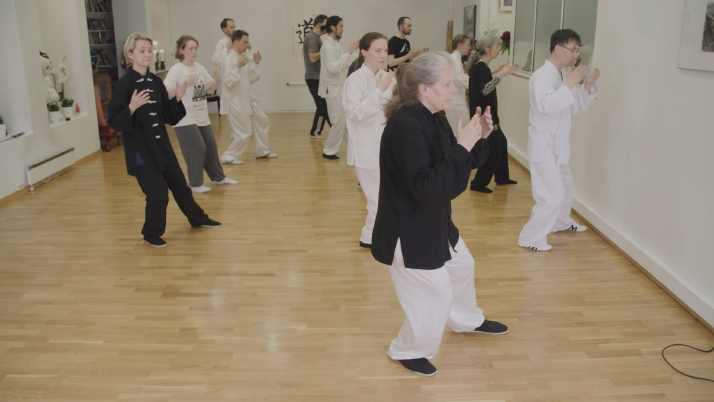‘This is heaven, this is Earth, and I am in between.”
With this simple phrase and a few slow, deliberate movements, Pamela Hiley introduces her students to tai chi (taiji).
Originally from Wales in the United Kingdom, Hiley has lived in Norway for more than four decades. As the founder and director of the Norwegian Taiji Center in Oslo, she is widely recognized as a pioneer of tai chi in the country.
But for Hiley, tai chi is far more than a graceful martial art or a form of physical exercise—it is a path to understanding oneself and connecting with the wider world. “Using tai chi as a reference has helped me open up this dialogue for inner peace and how to stay close to nature as a community,” she explained.
“When you practice for a long time, you start to realize it’s not just about the movements. It’s really about connecting to your truth. I haven’t found anything more interesting than that,” she told Beijing Review.

The path to tai chi
Hiley first encountered tai chi at the age of 20, while studying human movement and art at university. An accomplished athlete who once represented the UK in track events, she had always been fascinated by the capabilities of the human body.
Her academic curiosity about movement, combined with an artistic fascination with the color black—its depth and its relationship to light—eventually led her to tai chi.
Later, while pursuing postgraduate studies in London, she found a tai chi teacher. The practice struck a deep chord within her. “Tai chi can bring peace from within. This will spread naturally like the qi from a good heart, calm spirit and a deep resonance to what we feel with Earth and also with the heaven,” she said.
It is a powerful tool and philosophy that help people better understand themselves and others, she continued.
After a period of systematic study, she opened her own tai chi school in London. Later, following a personal invitation, Hiley moved to Norway, where she established a tai chi school. That was 42 years ago.
Back then, tai chi was not popular in Norway. “There were maybe a couple of Chinese old people in the park, but I was basically the first in Norway to establish a school,” Hiley said. “I couldn’t find anything better to do. I have a deep passion for getting to the heart of things, whether that’s my miserable self, my joyful self, or simply who I am. Tai chi created a space around me where I could feel relaxed, where I could teach what I experience.”

A channel of sharing
Hiley’s approach to tai chi is gentle, especially with beginners. She introduces philosophical ideas through movement, showing students how to feel the concepts in their bodies.
But her teaching goes far beyond posture. “What kind of attitude do you bring? Where are the challenges in your life—too much tension, or not enough?” she asks her students as she recognizes that people come to tai chi seeking solutions to a wide range of difficulties—physical, emotional or psychological.
“Everyone faces challenges. Some people come to the school hoping tai chi might help,” she explained. “So, I give them new challenges. I show them where they need to hold their posture. Then they forget all their other problems.”
After each class, she will sit down with her students and have a cup of tea. That’s how people relax and find out what’s going on in people’s lives, she said.
A bridge for understanding
When Hiley first began practicing tai chi, the brochure her teacher gave her featured the words “Wudang Mountain.” It stuck in her mind as a mystical, ancient place.
The Wudang Mountain, known as the cradle of internal martial art, holds a special place in the history and philosophy of tai chi. It embodies a deep connection to Daoist wisdom and the harmony between nature and humanity.
In 2008, driven by personal curiosity, Hiley brought 28 students to visit the Wudang Mountain in Hubei Province and Anyang in Henan Province, exploring the origins of tai chi and Chinese philosophy.
Some of her friends asked, “Why do you want to go to Anyang?” She replied, “Because it’s the beginning of Chinese language and history. I’m interested in how China reflects on its past and do the Chinese take that past seriously.”
In April 2025, Hiley led her ninth delegation to China, a two-week journey with 23 Norwegian students. In addition to tai chi exchanges, the group also experienced traditional Chinese culture.
For example, in Beijing, they visited a traditional Chinese medicine clinic, where they learned to make herbal sachets—believed to repel insects, improve circulation and bring calming effects. Some students also tried acupuncture and tuina massage, which aims to balance the body’s energy.
For Hiley, the trip was a continuation of her decades-long dialogue with Chinese masters. “Each visit brings a different dynamic,” she said, “depending on the interests of the delegation and our deepening friendship with the various masters we work with.”
Hiley feels encouraged to build stronger links between Norway and China through tai chi. “We are always welcomed with open arms, enthusiasm, love and with peaceful, kind people. It’s encouraging to build these links between Norway [and China], because maybe I just do a few movements, and the whole of China understands me,” she said. –The Daily Mail-Beijing Review news exchange item






